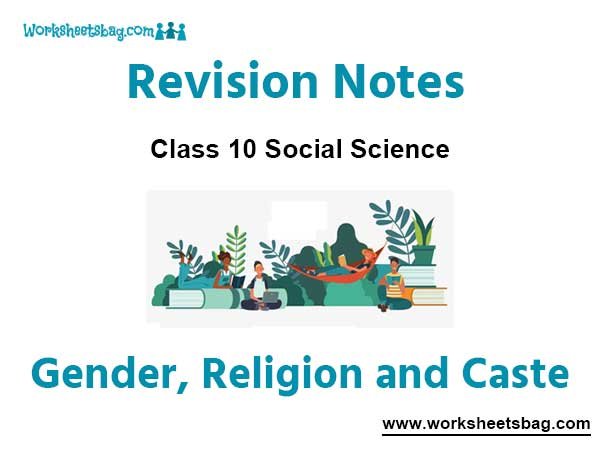Please refer to the Gender Religion and Caste Notes Class 10 Social Science given below. These revision notes have been designed as per the latest NCERT, CBSE, and KVS books issued for the current academic year. Students will be able to understand the entire chapter in your class 10th Social Science book. We have provided chapter-wise Notes for Class 10 Social Science as per the latest examination pattern.
Revision Notes Chapter 4 Gender Religion and Caste Class 10 Social Science
Students of Class 10 Social Science will be able to revise the entire chapter and also learn all important concepts based on the topic-wise notes given below. Our best teachers for Grade 10 have prepared these to help you get better marks in upcoming examinations. These revision notes cover all important topics given in this chapter.
GENDER
Sexual Division of labour- Woman do all the work inside the home or take the help of domestic helpers and men do work outside home.
Feminist Movement- A movement aimed at equality in personal and family life as well.(believe in equal rights and opportunities).
Role of Women in the society-
- Belief that responsibility of woman is house work and brining up children
- Their work were not valued and recognized
- Though constitute half the population their role is minimal especially in politics.
- Gender issue raised in politics- for equal rights, for voting, improve the political and legal status of women -for education &career (Feminist Movement)
Changing the Scenario of women’s role in public life
- Women working as Scientist, doctors, managers and college and university teachers.
- The participation of women in public life is high in developed Countries like Sweden, Norway and Finland.
Ways in which women are discriminated and oppressed-
- Literacy rate among women 54% and men 76% Reason – Girl students going for higher studies is less,
- More drop outs – as parents prefer to spend more for boys education
- Proportion of women in highly paid jobs are small
- The Equal Wages Act provides that equal wage must be paid – but women are paid less than men
- Parents prefer to have sons and so decline in sex – ratio
- Women are harassed and exploited in rural & urban areas – domestic violence
- Family laws of religions show discrimination against women
- Ours is still a male dominated, patriarchal society.
Women’s political representation
- Elected women member in Lok Sabha has not reached 10% and in State Assemblies 5% – very low
- A different scenario in Panchayat raj in India
- 1 I 3 Seat in the local government is in Panchayat’s and Municipalities – reserved for women- more than 10 Lakh women representatives in their bodies.
- Proposal of bill before the parliament -Reservation of at least 1/3 of seats in Lok Sabha and State Assemblies for women
Communalism–
1) The division based on religious differences – A major challenge to democracy.
Relationship between Religion and politics
- Gandhi’s view:- Religion can never be separated from politics- it must be guided by ethics from religion
- Human Right groups view- Victims of Communal riots in our country are religious minorities-
- Women’s Movement view – Family laws of religions discriminate against women demanded that such laws should be changed to make them equitable.
2) Various forms of communalism in politics :-
- Religious prejudices – belief in the superiority of one’s religion over other religions
- A communal mind leads to political dominance of one’s own religious Community – Special appeal in electoral politics involving the use of Sacred symbols, religious leaders, emotional appeal and plain fear to bring the followers together.
3) Constitutional provisions given in the Constitution base on Secularism, to curb communalism:
- No official religion for the Indian state – no special status.
- Freedom to profess, practice and propagate any religion.
- Prohibits discrimination on the grounds of religion.
- Ensures equality within religious communities.
4) Communal politics-
- Based on the idea that religion is the principle basis of social community
- State power is used to establish domination of one religious group over the rest.
- One religion and followers are pitted against another.
Caste :-
- Caste division based on
- hereditary occupational division
- exclusion and discrimination against our caste’ groups
- Causing social inequality.
Social reformers – who fought against Caste System are Gandhiji, Jotiba phule, B.R.Ambedkar, Periyar Ramaswami Naicker.
Reasons for changes undergone in Caste system
- Urbanization,
- occupational mobility,
- breaking down of caste hierarchy(old notions)
- Constitution of India prohibited any caste based discrimination
- Ban on un touch ability
- access to modern education.
5) Various forms of Caste in politics-
- To win elections parties choose candidates from different castes and tribes
- Make appeals to caste sentiments – favour some caste, and are seen as their representatives
- One person – one vote, No parliamentary constituency in the country has majority of one
- Single caste – so they need more than one caste, to win election.
- It brought a new consciousness among the people of caste that they were treated low
- The ruling party MP or MLA frequently loose election -will not happen if it was not Caste bias.
Result-
- Caste group become bigger by incorporating with other caste or sub caste
- Some Caste enter into dialogue and negotiation with other
- Formation of new caste groups – backward, forward caste groups.
SHORT ANSWER TYPE QUESTIONS
Question. Explain any three factors responsible for breaking down the caste hierarchy in our country?
Ans.
- With economic development, large scale urbanization, grovvth of literacy and education.
- Occupational mobility and weakening of the positions of landlords in the villages, the caste hierarchy is breaking down.
- The Constitution of India prohibited any caste-based discrimination. We don’t see the practice of untouchability anywhere today.
- Caste system also weakened due to the efforts of our political leaders and social reformers like Jyothiba Phule, Gandhiji, B.R. Ambedkar and Periyar Ramaswami Naicker.
Question. Explain the factors responsible for low female literacy rate in our country?
Ans.
- It is only a smaller proportion of girl students go for higher studies.
- Girls dropout because parent’s prefer to spend their resources for their boys
- education rather than spending equally on their sons and daughters.
Question. Explain any three forms of caste politics in India?
Ans.
- When parties choose candidates in elections, they keep in mind the caste composition of the electorate and nominate candidates from different castes so as to muster essential support to win elections.
- Political Parties and candidates in elections make appeals to cast sentiments of the electorate in order to muster support.
- When governments are formed, political parties usually take care that representatives of different caste and tribes find place in it.
Question. Give any three provisions that make India a secular state ?
Ans.
- There is no official religion for Indian state.
- The constitution provides to all individuals and communities freedom to profess, practice and propagate any religion.
- The Constitution prohibits discrimination on grounds of religion.
Question. Why was the Equal Remuneration Act,1976 passed?
Ans. In almost all areas of work, from sports and cinema, to factories and fields, women are paid less than men, even when both do exactly the same work. This Act provides that equal wages should be paid to equal work.
LONG ANSWER TYPE QUESTIONS
Question. What are the various ways by which women face discrimination, disadvantage and oppression in our society today?
Ans.
- The proportion of women among the highly paid and valued job is still very small.
- Parent’s prefer to spend their resources for their boys education rather than spending equally on their sons and daughters. Thus, the literacy rate among the women is low.
- Women are paid less than men, even when both do exactly the same work.
- In many parts of India parents prefer to have sons and find ways to have the girl child aborted.
- They are not safe even in their home today. Beating, harassment and other forms of domestic violence continue.
Question. Discuss any five steps taken by the government towards women empowerment and gender inequality.
Ans.
- One-third of seats in the local government bodies in Panchayats and Municipalities are now reserved for women.
- The provision of equal wages for women without any discrimination has been made under the Equal Wages Act.
- Female infanticide has been reduced as sex-selective abortions has been taken away, in many parts of the country.
- Domestic violence against women, their exploitation etc. has always been the part of daily news. In this regard, the government has brought Domestic Violence Act which proves and effective steps.
- Girl students are given concessions and free education in many states.
Question. What are the various forms that communalism can take in politics in India?
Ans.
- Communalism in daily beliefs – These routinely involve religious prejudices, stereotypes of religious communities and belief in the superiority of one’s religion over other religions. This is so common that we often fail to notice it, even when we believe in it.
- Formation of Politicalparties based on religious communities – A communal mind often leads to a quest for political dominance of one’s own religious community. For those belonging to majority communtty, this takes the form of majoritarian dominance. For those belonging to the minority community, it can take the form of a desire to form a separate political unit.
- Political mobilization on religious lines – It is another frequent form of communalism. This involves the use of sacred symbols, religious leaders, emotional appeal and plain fear in order to bring the followers of one religion together in political arena. In electoral politics this often involves special appeal to the interests or emotions of voters of one religion in preference to others.
- Communal Riots – Sometimes communalism takes its most ugly form of communal violence, riots and massacre. India and Pakistan suffered some of the worst communal riots at the time of the Partition. The post- Independence period has also seen large scale communal violence.



